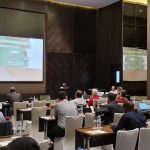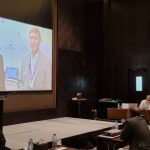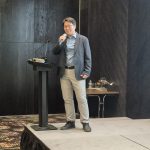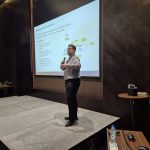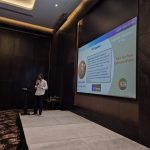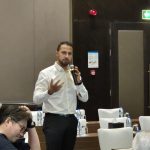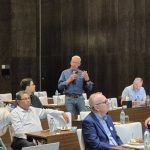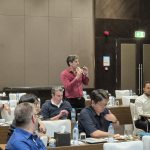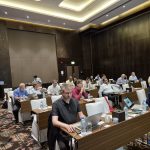The DRM Consortium General Assembly 2025, a global and comprehensive event, took place in Dubai, UAE, on May 16-17. Members from countries all over the world (India, Switzerland, Germany, UK, China, Hungary, Swaziland, Indonesia, South Africa, Oman, Kuwait, US, Canada, Latin America and so many other countries) were present physically and virtually contributing with presentations, comments and suggestions.
The first, full day, May 16th, open to members and guests, brought important news.
India remained in focus, especially after the recent WAVES summit in Mumbai, India. This was an opportunity for several key DRM members to showcase the big strides made by the DRM in expectation of the FM digitisation decision by the regulator and the government.
At the DRM General Assembly, the news from China took also centre stage. Two years ago, three Ministries in Beijing jointly released a notification document guiding the Chinese automotive industry to implement digital wireless reception modules in DRM and CDR. The country is now proceeding with the standardization of the two technologies, and the standard project plan was ready in April. The Chinese standards committee has approved the first round of the review already.
In the China DRM presentation there were also details about a recent event in Beijing (CCBN) where four DRM members and domestic partners jointly promoted a DRM end to end solution (at the Fraunhofer IIS booth). The GA participants were told on the 16th that the Chinese authorities (ABRS) showcased their achievements in DRM SW transmission, DRM Emergency Warning Functionality (EWF) and jointly conducted a live SW broadcasting and reception demonstration with SAIC Motor, the seventh largest automotive manufacturer in the world and largest carmaker in China.
For the current year China has a comprehensive plan of DRM testing in both shortwave and medium wave, also with focus on Emergency Warning Functionality (EWF) and AFS. Chinese DRM receivers of any size and for every platform were also presented to the General Assembly participants by Gospell from China. Other receiver and receiver technology manufacturers and solution suppliers presenting their latest developments were: Starwaves, RF2Digital, Elements Innovation, CML Micro (Solar Grove and Alongside Tech), NXP, OptM, Inntot, Skyworks, Fraunhofer IIS, RFmondial. They made for a lively session and discussion.
Linked to some of these companies was the groundbreaking news coming from Indonesia. A recently concluded digital-analogue radio trial took place on the Jawa island in Yogyakarta. A multi-standard receiver prototype (DRM, DAB+ and analogue), developed by the two Consortium members RF2Digital and Elements Innovation, delivered excellent results. The prototype could also be seen in action at the Dubai meeting. The Indonesian specialists who carried out the trial concluded in their final report that: “throughout the testing process, the prototype consistently captured signals with stability and delivered clear audio quality without any technical issues or operational difficulties.”
This is a first in the world and paves the way for a multi-standard receiver roll-out in other countries like South Africa, other African countries.
The recent success of the first ever DRM distance education project in West Africa and the interest shown at the recent pan-African e-learning event held in Tanzania, figured a lot in the discussions of the General Assembly. The effort made by DRM members like Encompass Media, Starwaves and Fraunhofer IIS was praised and commented on by other members like BBC, Ampegon, NXP etc. The future challenge is to continue and establish the project in the Gambia and other parts of the world with the help of other members and partners.
The receivers were practically mentioned in all the sessions of the General Assembly. The over 7 million cars with DRM receivers in India, many powered by NXP modules but of which over a million are kitted with Indian made Inntot solutions, as well as the CML Micro (and Cambridge Consultants)-based affordable receiver, N88, from DRM members Alongside Tech and Solar Grove (two US companies) were stimulating a lot of the discussions.
The consortium members have thus raised to the challenge of the perennial question: where are the DRM receivers? With the right decisions and involvement of the stakeholders, with broadcasts on the air, listeners can now enjoy DRM broadcasts in cars, on mobiles and at home.
A quiz and a pleasant Dubai Marina boat trip concluded a very fruitful first day of the DRM annual General Assembly.
On the 17th May the DRM members reviewed the undeniable DRM successes in 2024-2025 and set the strategy, as well as very ambitious targets in a demanding media environment, for the coming year.
For the DRM consortium chairman, Ruxandra Obreja, “this annual meeting was more of a forum for discussing new and unexpectedly good developments but also some new initiatives in Asia and Africa, the rest of the world. We have more members and more projects than ever before. We need to build on the great achievements of DRM in China, Indonesia, Pakistan, Nepal, Africa and elsewhere and be very clear that the open DRM digital standard is for all. DRM is efficient, saves money and offers services that leave no one behind.”

